“The Mata Hari of the Far East”: Uncovering the Incredible Story of Yoshiko Kawashima in Open Source Intelligence Reports
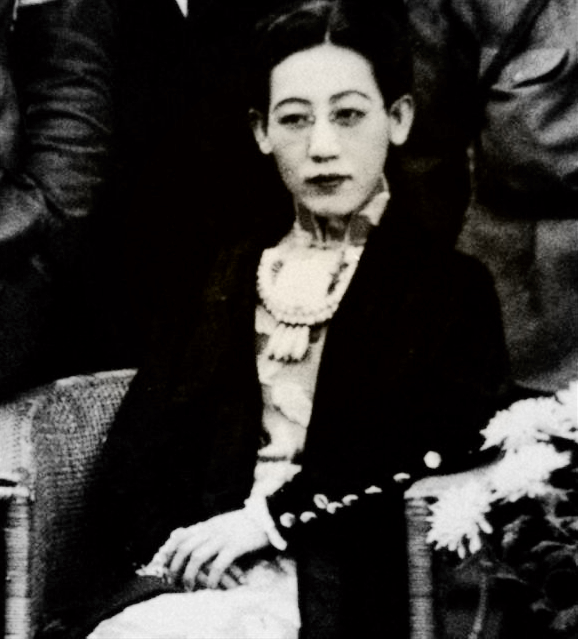
The story reads like a tale from a 1930s pulp fiction magazine: A cross-dressing Manchu princess makes a daring a nighttime escape by horseback across the steppes, becomes a spy for the Japanese, poses as a prostitute in opium dens around China and Siberia, is arrested and is executed—all set against the backdrop of the Chinese Revolution of 1912, the Japanese invasion of China, and World War II.
It may sound like fiction, but the true story of the Manchu princess, Yoshiko Kawashima, was of such interest to the United States government in the 1940s that a branch of the Central Intelligence Agency known as the Foreign Broadcast Information Service (FBIS) avidly gathered information about Kawashima. Among the articles selected and transcribed by the FBIS were three dispatches filed to Reuters from Chungking, China, on April 12, 13, and 14, 1945. They were reported in English Morse by “Correspondent Shen.” Shen opened his first dispatch this way:
While Henry Pu-yi, ‘Emperor of Manchukuo,’ is languishing in prison somewhere in Manchuria, another member of the Manchu Royal family is awaiting trial in Peiping. This is Toshiko Kawashima, the ‘Mata Hari of the Far East’, seventh daughter of the Manchu Prince Shu, pet name ‘Oriental Pearl’; adopted child of a Japanese; member of the Black Dragon Society; Number One woman spy in China; known as ‘Commander in Chief, King Pi-hui’ since the Mukden Incident in 1931; and dreaded by the Chinese as an evil genius.
She enjoyed a few years of regal splendor, then years of exile, followed by about 15 years of a fantastically checkered career, and now prison life.
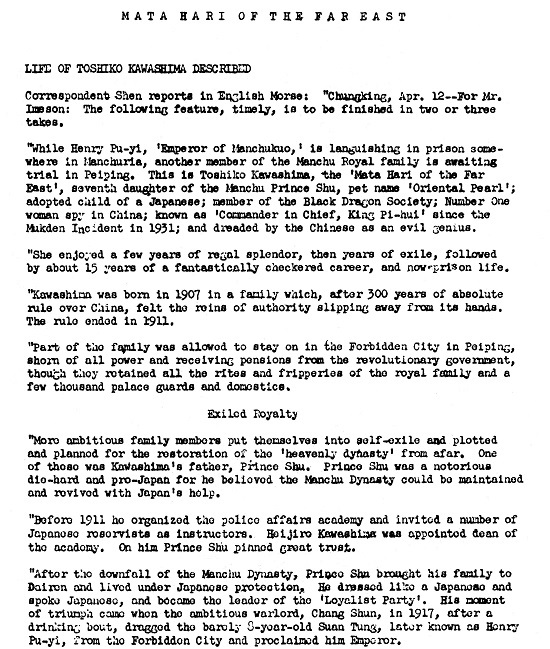
Shen, or the transcriber, misspelled the first name of the “Mata Hari of the Far East;” it’s Yoshiko, not Toshiko. She was born in 1907, daughter of Prince Shanqi, who was the 10th Prince Shu of the First Rank. (In Shen’s reporting he is referred to as Prince Shu.) Her birth name was Aisin Gioro Xianyu, and her courtesy name was Dongzhen (“Eastern jewel”). The Aisin Gioro was the imperial clan of the Manchu dynasty and was overthrown a few years after Xianyu’s birth.
Here’s how Shen recounts her early years:
Kawashima was born in 1907 in a family which, after 300 years of absolute rule over China, felt the reins of authority slipping away from its hands. The rule ended in 1911.
Part of the family was allowed to stay on in the Forbidden City in Peiping, shorn of all power and receiving pensions from the revolutionary government, though they retained all the rites and fripperies of the royal family and a few thousand palace guards and domestics.
More ambitious family members put themselves into self-exile and plotted and planned for the restoration of the ‘heavenly dynasty’ from afar. One of these was Kawashima’s father, Prince Shu. Prince Shu was a notorious die-hard and pro-Japan for he believed the Manchu Dynasty could be maintained and revived with Japan’s help.
Before 1911 he organized the police affairs academy and invited a number of Japanese reservists as instructors. Heijiro Kawashima was appointed dean of the academy. On him Prince Shu pinned great trust.
After the downfall of the dynasty, Prince Shu lived under Japanese protection. According to Shen, he dressed like a Japanese and spoke Japanese. Then he backed a warlord who was trying to put the 8-year-old Henry Pu-yi on the throne.
But his moment of triumph was short lived. Only for one week Chang Shun reigned as the real power behind the throne. Then he was kicked out of Peiping by Tuan Chi-jui and Feng Kuo-chang.
With his hopes shattered, Prince Shu went to Japan broken hearted and shortly afterward committed suicide at Port Arthur by swallowing metals, leaving behind 38 children by his wife and concubines. Of the 38 children, ‘Oriental Pearl’, as he fondly called her, was his favorite. She was now about 10 years old.
How 'Oriental Pearl' came to be adopted by Hoijiro Kawashima is not clear. Some said Prince Shu left her with the Kawashimas to ‘bring more life and harmony’ to the childless family. Whatever it was, ‘Oriental Pearl’ became adopted by Hoijiro and henceforth known as Toshiko Kawashima.
She received a secondary education in Japan and spent one year in a girls’ school. Then she entered a boys’ high school dressed like a boy and using a boy’s name. Perhaps she acquired the habit of dressing like a man.
When 17 she was sent to a military academy. On graduation, after 2 years, she was well versed in war science and espionage work. Besides a normal education, the young girl was put by Hoijiro through various mysterious processes supposed to be necessary for attaining the Bushido spirit.
“Besides a normal education…” seems like a stretch.
On graduation from the military academy, Kawashima, in the flower of youth, was blooming and beautiful. Under normal circumstances such a girl would be expected to be happy and gay. But not Kawashima. It was during this period that she made three attempts on her own life for reasons unknown. Some said the beast of an adopted father violated her.
Whatever it was, from that time on relations between Heijiro and the girl were broken, and the girl embarked on a dissipated and sensual life.”
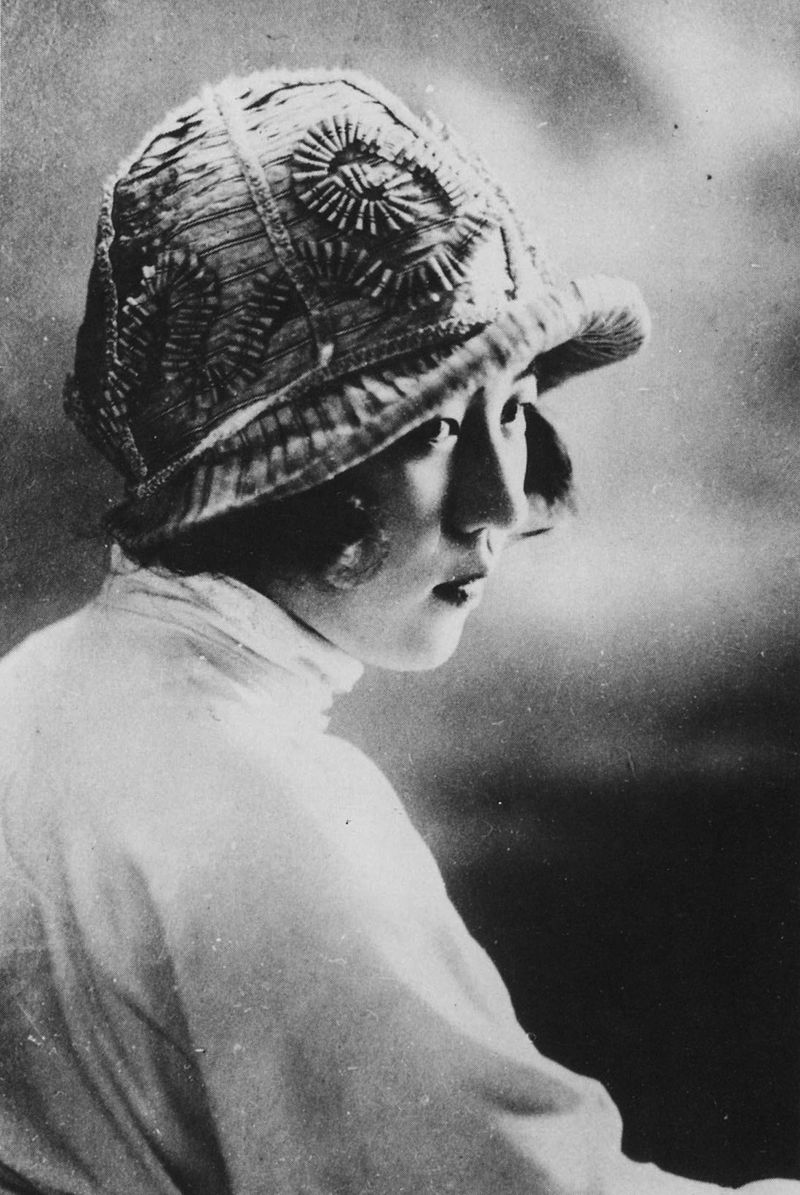
Thus ends Shen’s first dispatch about Kawashima. He continues her story the next day:
Apr. 13 Transmission—Chungking, Apr. 13—Toshiko Kawashima story:
The great turning point of Kawashima’s life came when she was discovered by the Black Dragon Society—saber and stirrup clique of the Japanese jingoists, dreaming a dream of continental empire and world conquest. As a political move aimed at hegemony over Manchuria and Mongolia, they decided to present Kawashima to a Mongolian Prince dubbed Hsiao Han as a concubine. This move caused immense sorrow to a young man serving Marshal Chan Tso-lin. This young man was Wang Ying-tai, who later became head of the Japanese-sponsored regime in North China and is now awaiting trial like Kawashima.
Let’s identify some of these people. Chang Tso-lin is transliterated today as Zhang Zoulin. He was the warlord of Manchuria. Killed by a bomb planted by the Japanese in 1928, he was succeeded by his son. Zhang was referred to as “The Old Marshal” and his son, Zhang Xueliang, became known as “The Young Marshal.” Wang Ying-tai, now transliterated as Wang Yintai, was an official in Zhang Zoulin’s government. The Young Marshal is best known for kidnapping Chiang Kai-shek, the Nationalist leader, and forcing him to meet with Zhou Enlai to discuss joining forces to fight the Japanese. The Young Marshal spent many years under house arrest after this, first in Nanjing, then in Taiwan after the Kuomintang fled there.
Kawashima became a concubine to Hsiao Han, as described in Shen’s report.
At first Kawashima was content; but used to city life, she rapidly grew tired of the desert life and impatient with its monotony and boredom. One evening she dressed in scarlet, raced through the brown desert on a white horse, and managed to escape to Japan.
The Black Dragon Society naturally was greatly annoyed, but impressed with her sagacity and dashing personality, decided to give her another role to play. Thus Kawashima became connected with the Kwantung Army. Thus as a spy she found herself. Doihara, the ‘Lawrence of the Far East’, was secret service head of the Kwantung Army. He came to China in 1915, and became adviser to Marshal Chang Tso-lin 2 years later.
Kenji Doihara ended World War II as a general in the Imperial Japanese Army and was executed as a Class A war criminal. Among other things, he engineered the accession of Henry Pu-yi to the throne of Manchukuo, the puppet state the Japanese created in Manchuria.
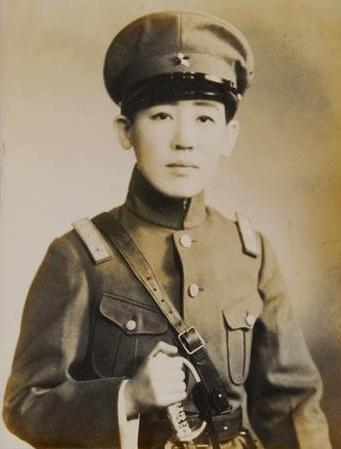
Shen continues.
He [Doihara] so distinguished himself in espionage work in China that in 10 years he, who started as a mere captain, achieved a full generalship….
It was under him that Kawashima matured and grew to full stature. Doihara’s experienced eye readily saw the kind of woman she was, and took her into his confidence. Kawashima became his right hand, and some said his mistress. Her name spread until she was regarded by the Chinese as a precursor of ill.
Her first assignment was an inspection tour in the Northeast under the disguise of a woman teacher or tourist. She made connections with educators and newsmen and tried to worm into the confidence of civil and military authorities in different localities.
Great efforts were exerted to change the people’s minds regarding Japan. A lot of money was spent to buy over the scum of society to serve as fifth columnists. She frequented opium and morphine dens as a Chinese or (Korean) prostitute to mix with petty officials and officers. It is said that about 400 Japanese spies worked under her at that time.
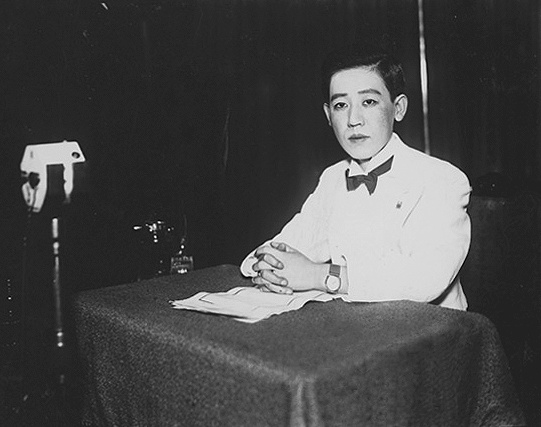
Correspondent Shen then details her spying for Japan in Mukden, Siberia, Shanghai, Jehol and Tientsin. At Tientsin:
In the dim passion-feated atmosphere of ballrooms she was now known as the dancing girl, Wan Hsien-pai. She would prick up her ears and gather news. For a similar purpose she opened a restaurant in Tientsin in 1936—the Tunghshien Restaurant. This restaurant drove to a roaring business.
Once in a while she would visit it in a splendid uniform, accompanied by four or five bodyguards. She would be shown to room number one and was greeted as General Wang. The pomp surrounding her and her arrogance remind one of the dying race of warlords.
One writer described General Wang as capable of speaking perfect Mandarin and other Chinese dialects, perfect Japanese and English, and having a square face and broad eyebrows.
Shen continues his colorful dispatch the following day:
April 14 Transmission—When the war spread to Central China in 1937 Kawashima showed up in Shanghai again. Once she was disguised as a Chinese soldier and was active in the … north railway station area. Shortly afterwards she went to Hong Kong, where she registered at the Queen Restaurant as Li Sung-hsiang and got into close quarters with Chen Yao-chu, brother-in-law of the Number 1 puppet, Wang Ching-wei. Chen later was assassinated by patriots when (he was) governor of Kwangtung under the Japanese-sponsored Nanking Regime.
So far Kawashima had led a wandering life. Now, with the Japanese occupation of North China, she settled down in Peiping, sure of position and power. Usually she dressed up like a Manchu nobleman, in a long gown, cape, satin boots, and a skull cap with a white or green jade knot. Her liking for a man’s dress dated from her school days. In this connection once she said: ‘The color in a man’s dress is a protective color to me. Formerely [sic] I received scores of nonsensical love letters daily. The number has been greatly reduced since I found a protective color.’
The life she led in Peiping was one of long debauchery and sensuality. She had a number of lovers who incessantly quarreled for greater favors from her.
Shen talks about her lovers in some detail, and then describes her influential position among the Japanese officials and gendarmes.
Kawashima was held in awe by the Japanese gendarmes. A word from her was enough to restore freedom to any Chinese arrested by the gendarmes, or cause death to him.
The story goes that on a visit to Yisoyuan, Kawashima’s driver was offended by the driver of a gendarme chief. Kawashima was so furious that she summoned the gendarme chief, scolded him, and ordered him to drive her some by way of punishment. The gendarme chief meekly obeyed.
Because of such influence, Kawashima’s house was always filled with Chinese begging for favors. Kawashima’s house in Peiping was like a fortress, full of snares and traps. It is said that 29 police dogs, a number of monkeys, and two white geese which had been given special training watched the doors. But the bars, snares, traps, and police dogs were useless when the Japanese war chariot to which Kawashima had pitched her fate was knocked out. Ever since the spring of 1945 she had been closely watched by two secret service men from Chungking. They had succeeded in getting one of their men into Kawashima’s house as a servant. Through him they kept themselves informed of Kawashima’s movements….
Her arrest was made when the surrender was being signed of the Forbidden City from which Kawashima’s (henchmen) once issued orders reaching to the farthest ends of the Chinese empire.
Kawashima went on trial in 1946. On July 4, 1946, FBIS had a short transcript of a broadcast in English Morse about Kawashima. It was titled “’Mata Hari’ to Be Tried as Traitor.”
Miss Yoshiko Kawashima, Alias Chin Pi-hui, notorious Manchu woman spy for Japan and known as the ‘Mata Hari’ of the Far East, will soon be arraigned before the Hopeh High Court here. She is detained by Chinese military authorities and was recently transferred over to the judicial authorities here. She will be tried under Chinese laws as a traitor.
In a covering document transferring her for trial before the Hopeh Court, the following charges are brought against her by the Chinese military authorities:
Chin Pi-hui is a daughter of Prince Chun Ching of the Manchu Dynasty, born and brought up in Japan, where she took the name of Miss Yoshiko Kawashima; as a Japanese woman spy, she returned to China after the Manchurian Incident, engaging in secret service activities on behalf of the Japanese government in Manchuria, Tientsin, and Peiping.
As First Lady of Chambermaids in the puppet Royal Manchurian court, and chairman of the Japanese Returned Students Association in Manchuria, she took a leading part in welcoming the visit of puppet Emperor Henry Pu-yi to Tokyo; she helped in organizing bandits under Chen Kuo-jui into the puppet National (Salvation) Army.
As liaison agent between the Japanese and puppet Wang Ching-wei, she was instrumental in persuading the latter to betray his country by establishing a bogus Nanking regime; as radio commentator and contributor of articles to the press, she supplied the enemy with valuable military and political information on the Chinese Government in Chungking.
In an attempt to reestablish the Manchu domination over China, she tried to instigate Henry Pu-yi to remove his capital to Peiping.
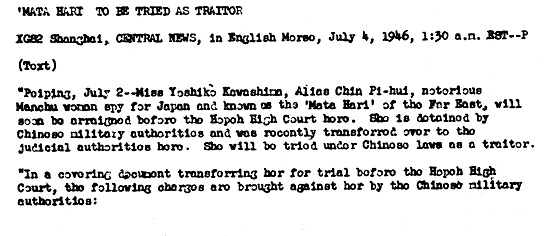

Kawashima was convicted in the fall of 1947 and executed in the spring of 1948.
You might be thinking, why hasn’t a life this interesting become a novel? It has. Maureen Lindley’s The Private Papers of Eastern Jewel, published in the United States in 2010, is based on Kawashima’s life. Lindley added fictional elements to her book, but the story of a cross-dressing Manchu princess who made a daring nighttime escape by horseback, became a spy for the Japanese, and posed as a prostitute in opium dens around China and Siberia is so incredible, one hardly needs fictional elements to sensationalize it.
For more information about Readex’s digital edition of Foreign Broadcast Information Service Daily Reports, 1941-1996, please contact Readex Marketing.



